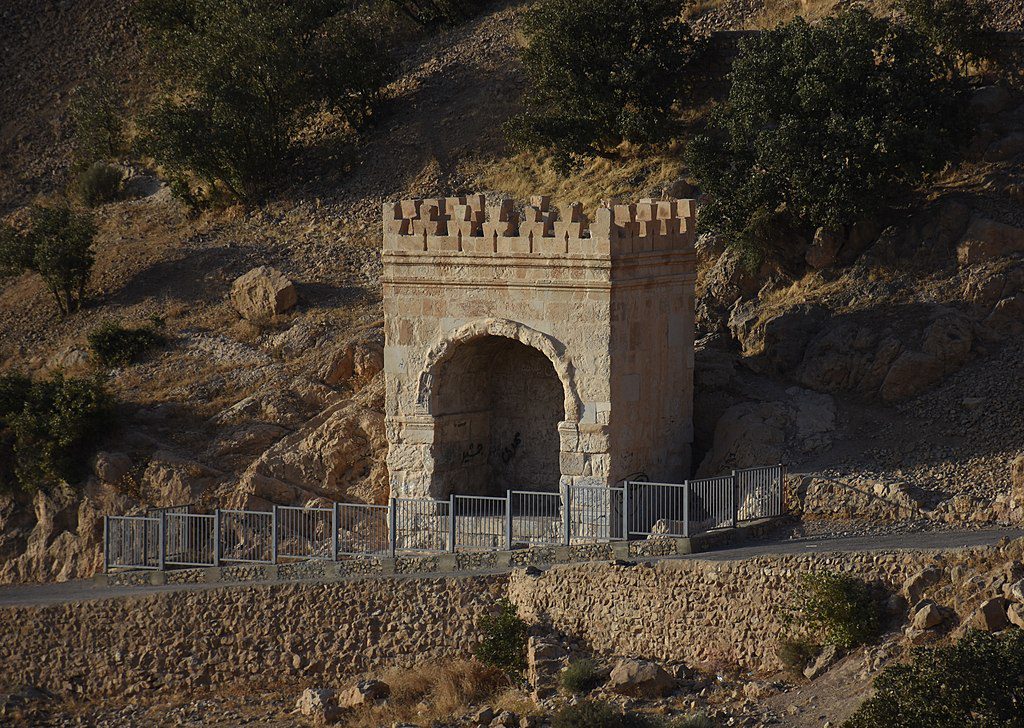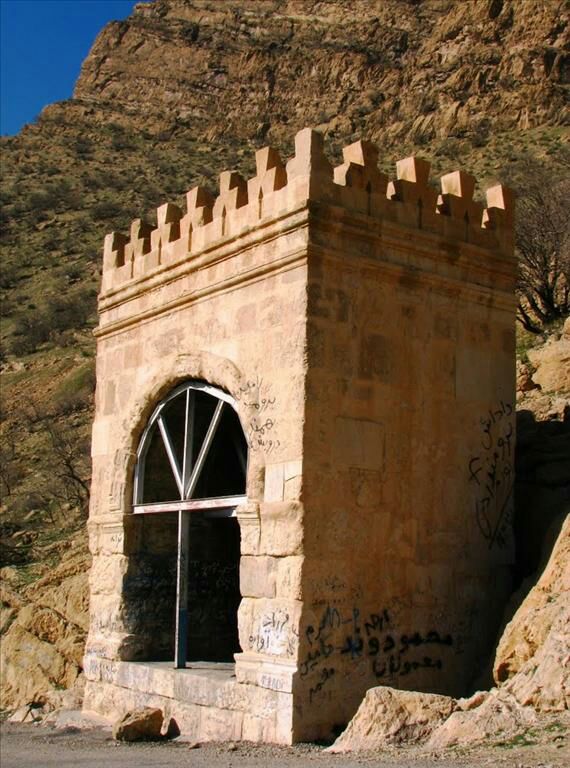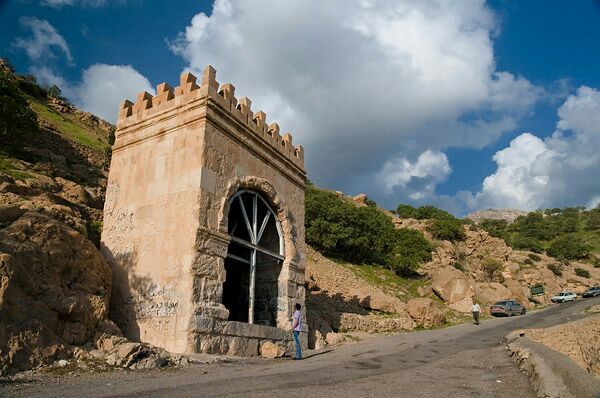Table of Contents
Are you a history buff or someone who loves exploring ancient sites? If so, then Taq-e Gara in Kermanshah Province, Iran, is a destination you must not miss. This magnificent stone structure, also known as Taq-e Shirin, dates back to the Sasanian Empire and is located in the Pataq Pass, also known as the Gate of Zagros. In this guide, we’ll take you on a journey through the history and beauty of Taq-e Gara, exploring the zigzagging road leading to the arch, its role as a border station, nearby attractions, and the significance of the ancient road beside it.
The Enigmatic History of Taq-e Gara
Taq-e Gara is a rectangular stone structure that stands about 7 meters high and has an enigmatic history. Although its precise construction date remains uncertain, it is believed to have been built during the Sasanian period, possibly during the reign of Khosrow II. Despite the many theories surrounding its purpose, the exact reason for its construction remains a mystery. Some suggest that it was a “monument of the construction of the caravan route,” “royal procession stop,” “border post,” or “victory monument.”
Located in the Pataq Pass, Taq-e Gara was likely responsible for guarding Iran’s western borders. The zigzagging road leading to the arch has an 11,000-year-old history and has served as a crucial connection between Mesopotamia and the Iranian Plateau. Inside the arch, stunning geometric patterns carved into the stone will leave you captivated and in awe.

Kermanshah Province
Kermanshah Province is located in the western part of Iran and is known for its rich history and natural beauty. The province is home to several historical sites that date back to different periods, including the Sassanid era, which was one of the most significant periods in the region’s history.
Sassanid Attractions
The Sassanid era was a golden age for Iran, and Kermanshah Province has several historical sites from this period that are worth exploring. One of the most famous Sassanid attractions in the region is the Tagh-e Bostan complex, located in the outskirts of Kermanshah city, 2 hours away from Taq-e Gara. The complex consists of several rock reliefs and sculptures that depict scenes from the Sassanid era, including the coronation of Khosrow II and his military victories. The complex also includes a large arch-shaped rock carving that is said to be one of the most significant rock reliefs in Iran.
Another notable Sassanid attraction in Kermanshah Province is the Temple of Anahita, located in Kangavar, which is about a 3-hour drive from Taq-e Gara. This temple was dedicated to Anahita, the goddess of water and fertility, and is believed to have been built during the reign of Khosrow II. The temple’s architecture is a unique blend of Sassanid and Parthian styles, and it is considered one of the most important religious sites from the Sassanid era.
Popular Attractions in Kermanshah
Apart from the Sassanid attractions, Kermanshah is home to several other notable historical and natural sites. One of the most famous attractions in the region is the Bisotun Inscription, located about 30 kilometers east of Kermanshah city. This inscription is a UNESCO World Heritage Site and depicts the victory of Darius I over several rebel tribes.
On your way from Kermanshah to Sarpol-e Zahab which contains Taq-e Gara, you can also visit Dokan Dawood, a stone tomb from the Medes era, which is a registered national heritage site and worth a visit. You can also explore the villages of Sorkh Dizeh, Pataq, and Kal Dawood, which are home to beautiful nature and historic buildings from the ancient Iranian era.
Another popular attraction in Kermanshah Province is the Taq-e Bostan Lake, located near the Tagh-e Bostan complex. The lake is surrounded by mountains and provides a picturesque setting for picnics and boat rides. The city of Kermanshah itself is also worth exploring, with its bustling bazaars, mosques, and historical sites.

The Importance of the Ancient Road Beside Taq-e Gara
The ancient road leading to Taq-e Gara is a crucial part of the region’s history. This road, known as the Pataq Pass, has been in use for over 11,000 years and has served as a vital connection between Mesopotamia and the Iranian Plateau. The pass was also a crucial trade route for merchants, who transported goods between the east and west along this ancient road.
The Pataq Pass is also significant because it played a crucial role in the defense of Iran’s western borders. Taq-e Gara, which was likely responsible for guarding the western borders, was strategically located in the pass, making it an essential defense post. The pass allowed the Sassanid army to defend against invading forces and ensure the safety of the region’s inhabitants.
Today, the Pataq Pass and the ancient road leading to Taq-e Gara continue to be an essential part of the region’s history and heritage. The pass has been preserved, and visitors can take a scenic drive or hike along the ancient route, taking in the breathtaking views of the surrounding mountains and valleys.
Planning Your Visit
Best time to visit
If you’re planning a trip to Taq-e Gara and Kermanshah Province, there are a few things to keep in mind. The best time to visit the region is during the spring and fall when the weather is mild and pleasant. Summer can be hot and humid, while winter can be cold and snowy, especially at higher elevations.
If you plan to visit Taq-e Gara, keep in mind that it is located in a remote area, and the road leading to it can be challenging to navigate. It is best to hire a local guide or join a guided tour to ensure a safe and comfortable trip. Additionally, visitors should dress modestly and respectfully and follow local customs and traditions.
Food and Lodging options
There are no restaurants or accommodations around Taq-e Gara but when visiting Kermanshah Province, there are several accommodation options available, ranging from budget-friendly guesthouses to luxury hotels. The city of Kermanshah is the best place to stay, as it offers easy access to the region’s attractions and amenities.
Conclusion
In conclusion, Taq-e Gara and Kermanshah Province offer a fascinating glimpse into Iran’s rich history and culture. From the enigmatic stone arch to the ancient road, the region’s attractions are a testament to its strategic importance and the legacy of the Sassanid Empire. Whether you’re a history buff or someone who loves exploring natural beauty, Kermanshah Province is a destination that should not be missed.
FAQs about Taq-e Gara
Q: What is Taq-e Gara?
A: Taq-e Gara is a rectangular stone structure located in the Pataq Pass of Kermanshah Province, Iran. Its exact purpose remains a mystery.
Q: What are the nearby attractions to Taq-e Gara?
A: Kermanshah Province is home to many fascinating historical sites, including Dokan Dawood, a stone tomb from the Medes era, and the villages of Sorkhe Dizeh, Pataq, and Kal Dawood,
Q: How do I get to Taq-e Gara?
A: To reach Taq-e Gara, you can use your personal vehicle and turn onto the side road on the left side of the main road about 200 meters after the Pataq checkpoint. Then, travel a distance of approximately 500 meters. If you don’t have a vehicle, you can get off near Rajab Road shortly after the checkpoint.
Q: How much is the entrance fee?
A: There is no entrance fee to visit Taq-e Gara.
Q: Is there any parking lot?
A: Yes, there is a car parking area available for visitors in the checkpoint.
Q: Is there any restaurant or accommodation around Taq-e Gara?
A: There are no restaurants or accommodations around Taq-e Gara. However, you can visit nearby villages and cities such as Kermanshah and Sarpol-e Zahab for food and lodging options.
Unlock the Mysteries of Iran’s Archaeological Treasures with a Knowledge-Based Tour
If you are an avid history enthusiast and seeking an unparalleled travel experience, there is no better destination than Iran, a country with a rich and diverse cultural heritage spanning thousands of years. Exploring the archaeological sites of Iran allows you to delve into the depths of history and witness the remnants of ancient civilizations that have shaped this land.
To fully immerse yourself in the wonders of Iran’s archaeological sites, embarking on a knowledge-based and archaeological tour is highly recommended. Such a tour not only grants you access to renowned archaeological sites but also offers a comprehensive understanding of their historical significance and the stories they hold.
Introducing ToIranTour: Crafting Unforgettable Journeys
When it comes to arranging customised tours and providing exceptional travel experiences in Iran, ToIranTour stands out as a premier travel agency. With years of expertise in organising Iran tours and travel packages, ToIranTour understands the discerning preferences of travelers who seek to uncover the hidden gems of this captivating country.
At ToIranTour, we take pride in curating tours that cater to your specific interests and preferences. Whether you are captivated by the ancient ruins of Persepolis, fascinated by the exquisite architecture of Isfahan, or intrigued by the ancient Silk Road cities like Yazd and Shiraz, we design your itinerary to ensure you make the most of your time in Iran.
